在iOS 11中,sizeThatFits方法不再从UINavigationBar子类中调用。改变UINavigationBar的框架会导致故障和错误的插入。那么,现在有什么想法来自定义Navbar高度呢?
iOS 11导航栏高度自定义
14
根据苹果开发者的说法(在此处,这里和这里),iOS 11中不支持更改导航栏高度。在这里他们建议采用解决方法,例如将一个视图放在导航栏下面(但不包括它),然后移除导航栏边框。结果在storyboard中会得到这样的效果:
在设备上看起来像这样:
现在你可以尝试另一篇答案中提供的解决方式:创建一个UINavigationBar的自定义子类,并将自定义的大的子视图添加到其中,重写sizeThatFits和layoutSubviews,然后将导航的顶控制器的 additionalSafeAreaInsets.top设置为差值customHeight - 44px,但是导航栏视图仍将保持默认的44px,尽管在视觉上一切看起来完美。我没有尝试重写setFrame,也许会奏效,但是正如苹果开发者在上面提到的一个链接中写道:"…同样也不支持更改由UINavigationController拥有的导航栏的框架(导航控制器将随时随地随心所欲地践踏您的框架更改)"。
在我的情况下,上述解决方法使视图呈现以下效果(调试视图以显示边框):
如您所见,视觉效果相当不错,additionalSafeAreaInsets成功将内容向下推,大导航栏可见,但我在此栏中有一个自定义按钮,只有标准44像素导航栏下面的区域是可点击的(绿色区域在图中)。低于标准导航栏高度的触摸无法触及我的自定义子视图,因此我需要调整导航栏本身的大小,但苹果开发人员表示这是不支持的。
6
override func hitTest(_ point: CGPoint, with event: UIEvent?) -> UIView? {
return subviews.reduce(super.hitTest(point, with: event)) { (result, subview) in
return result ?? subview.hitTest(convert(point, to: subview), with: event)
}
}对于格式不当,我们表示抱歉。 - MarkII更新于2018年1月7日
此代码支持XCode 9.2,iOS 11.2。
我也遇到了同样的问题。以下是我的解决方案。我假设高度大小为66。
如果有帮助,请选择我的答案。
创建CINavgationBar.swift文件。
import UIKit
@IBDesignable
class CINavigationBar: UINavigationBar {
//set NavigationBar's height
@IBInspectable var customHeight : CGFloat = 66
override func sizeThatFits(_ size: CGSize) -> CGSize {
return CGSize(width: UIScreen.main.bounds.width, height: customHeight)
}
override func layoutSubviews() {
super.layoutSubviews()
print("It called")
self.tintColor = .black
self.backgroundColor = .red
for subview in self.subviews {
var stringFromClass = NSStringFromClass(subview.classForCoder)
if stringFromClass.contains("UIBarBackground") {
subview.frame = CGRect(x: 0, y: 0, width: self.frame.width, height: customHeight)
subview.backgroundColor = .green
subview.sizeToFit()
}
stringFromClass = NSStringFromClass(subview.classForCoder)
//Can't set height of the UINavigationBarContentView
if stringFromClass.contains("UINavigationBarContentView") {
//Set Center Y
let centerY = (customHeight - subview.frame.height) / 2.0
subview.frame = CGRect(x: 0, y: centerY, width: self.frame.width, height: subview.frame.height)
subview.backgroundColor = .yellow
subview.sizeToFit()
}
}
}
}
设置故事板
设置自定义NavigationBar类
添加TestView + 设置SafeArea
ViewController.swift
import UIKit
class ViewController: UIViewController {
var navbar : UINavigationBar!
@IBOutlet weak var testView: UIView!
override func viewDidLoad() {
super.viewDidLoad()
//update NavigationBar's frame
self.navigationController?.navigationBar.sizeToFit()
print("NavigationBar Frame : \(String(describing: self.navigationController!.navigationBar.frame))")
}
//Hide Statusbar
override var prefersStatusBarHidden: Bool {
return true
}
override func viewDidAppear(_ animated: Bool) {
super.viewDidAppear(false)
//Important!
if #available(iOS 11.0, *) {
//Default NavigationBar Height is 44. Custom NavigationBar Height is 66. So We should set additionalSafeAreaInsets to 66-44 = 22
self.additionalSafeAreaInsets.top = 22
}
}
override func didReceiveMemoryWarning() {
super.didReceiveMemoryWarning()
// Dispose of any resources that can be recreated.
}
}
SecondViewController.swift
import UIKit
class SecondViewController: UIViewController {
override func viewDidLoad() {
super.viewDidLoad()
// Do any additional setup after loading the view.
// Create BackButton
var backButton: UIBarButtonItem!
let backImage = imageFromText("Back", font: UIFont.systemFont(ofSize: 16), maxWidth: 1000, color:UIColor.white)
backButton = UIBarButtonItem(image: backImage, style: UIBarButtonItemStyle.plain, target: self, action: #selector(SecondViewController.back(_:)))
self.navigationItem.leftBarButtonItem = backButton
self.navigationItem.leftBarButtonItem?.setBackgroundVerticalPositionAdjustment(-10, for: UIBarMetrics.default)
}
override var prefersStatusBarHidden: Bool {
return true
}
@objc func back(_ sender: UITabBarItem){
self.navigationController?.popViewController(animated: true)
}
//Helper Function : Get String CGSize
func sizeOfAttributeString(_ str: NSAttributedString, maxWidth: CGFloat) -> CGSize {
let size = str.boundingRect(with: CGSize(width: maxWidth, height: 1000), options:(NSStringDrawingOptions.usesLineFragmentOrigin), context:nil).size
return size
}
//Helper Function : Convert String to UIImage
func imageFromText(_ text:NSString, font:UIFont, maxWidth:CGFloat, color:UIColor) -> UIImage
{
let paragraph = NSMutableParagraphStyle()
paragraph.lineBreakMode = NSLineBreakMode.byWordWrapping
paragraph.alignment = .center // potentially this can be an input param too, but i guess in most use cases we want center align
let attributedString = NSAttributedString(string: text as String, attributes: [NSAttributedStringKey.font: font, NSAttributedStringKey.foregroundColor: color, NSAttributedStringKey.paragraphStyle:paragraph])
let size = sizeOfAttributeString(attributedString, maxWidth: maxWidth)
UIGraphicsBeginImageContextWithOptions(size, false , 0.0)
attributedString.draw(in: CGRect(x: 0, y: 0, width: size.width, height: size.height))
let image = UIGraphicsGetImageFromCurrentImageContext()
UIGraphicsEndImageContext()
return image!
}
override func didReceiveMemoryWarning() {
super.didReceiveMemoryWarning()
// Dispose of any resources that can be recreated.
}
}
黄色是barbackgroundView。黑色不透明度是BarContentView。
我移除了BarContentView的backgroundColor。
就是这样。
9
layoutSubviews(),导致应用程序冻结。 - Michael这对我有效:
- (CGSize)sizeThatFits:(CGSize)size {
CGSize sizeThatFit = [super sizeThatFits:size];
if ([UIApplication sharedApplication].isStatusBarHidden) {
if (sizeThatFit.height < 64.f) {
sizeThatFit.height = 64.f;
}
}
return sizeThatFit;
}
- (void)setFrame:(CGRect)frame {
if ([UIApplication sharedApplication].isStatusBarHidden) {
frame.size.height = 64;
}
[super setFrame:frame];
}
- (void)layoutSubviews
{
[super layoutSubviews];
for (UIView *subview in self.subviews) {
if ([NSStringFromClass([subview class]) containsString:@"BarBackground"]) {
CGRect subViewFrame = subview.frame;
subViewFrame.origin.y = 0;
subViewFrame.size.height = 64;
[subview setFrame: subViewFrame];
}
if ([NSStringFromClass([subview class]) containsString:@"BarContentView"]) {
CGRect subViewFrame = subview.frame;
subViewFrame.origin.y = 20;
subViewFrame.size.height = 44;
[subview setFrame: subViewFrame];
}
}
}
新增: 这个问题在iOS 11 beta 6中已得到解决,所以下面的代码已经没有用了 ^_^
原始回答:
使用下面的代码来解决:
(我总是希望navigationBar.height + statusBar.height == 64,无论statusBar是否隐藏)
@implementation P1AlwaysBigNavigationBar
- (CGSize)sizeThatFits:(CGSize)size {
CGSize sizeThatFit = [super sizeThatFits:size];
if ([UIApplication sharedApplication].isStatusBarHidden) {
if (sizeThatFit.height < 64.f) {
sizeThatFit.height = 64.f;
}
}
return sizeThatFit;
}
- (void)setFrame:(CGRect)frame {
if ([UIApplication sharedApplication].isStatusBarHidden) {
frame.size.height = 64;
}
[super setFrame:frame];
}
- (void)layoutSubviews
{
[super layoutSubviews];
if (![UIApplication sharedApplication].isStatusBarHidden) {
return;
}
for (UIView *subview in self.subviews) {
NSString* subViewClassName = NSStringFromClass([subview class]);
if ([subViewClassName containsString:@"UIBarBackground"]) {
subview.frame = self.bounds;
}else if ([subViewClassName containsString:@"UINavigationBarContentView"]) {
if (subview.height < 64) {
subview.y = 64 - subview.height;
}else {
subview.y = 0;
}
}
}
}
@end
6
subview是一个UIView。之后你是如何做到subview.height的呢? - sudoExclaimationExclaimation使用Swift 4进行简化。
class CustomNavigationBar : UINavigationBar {
private let hiddenStatusBar: Bool
// MARK: Init
init(hiddenStatusBar: Bool = false) {
self.hiddenStatusBar = hiddenStatusBar
super.init(frame: .zero)
}
required init?(coder aDecoder: NSCoder) {
fatalError("init(coder:) has not been implemented")
}
// MARK: Overrides
override func layoutSubviews() {
super.layoutSubviews()
if #available(iOS 11.0, *) {
for subview in self.subviews {
let stringFromClass = NSStringFromClass(subview.classForCoder)
if stringFromClass.contains("BarBackground") {
subview.frame = self.bounds
} else if stringFromClass.contains("BarContentView") {
let statusBarHeight = self.hiddenStatusBar ? 0 : UIApplication.shared.statusBarFrame.height
subview.frame.origin.y = statusBarHeight
subview.frame.size.height = self.bounds.height - statusBarHeight
}
}
}
}
}
1
除了覆盖-layoutSubviews和-setFrame:之外,如果您不希望调整大小的导航栏隐藏内容,还应该查看新添加的UIViewController的additionalSafereaInsets属性(Apple Documentation)。
2
addionalSafeAreaInsets,特别是如何允许iOS 10及以下版本不支持此属性。 - JoGoFoadditionalSafeAreaInsets,特别是如何允许iOS 10及以下版本不支持此属性。 - JoGoFoUINavigationBar 中重写 layoutSubviews,然后使用以下代码:- (void)layoutSubviews
{
[super layoutSubviews];
for (UIView *subview in self.subviews) {
if ([NSStringFromClass([subview class]) containsString:@"BarBackground"]) {
CGRect subViewFrame = subview.frame;
subViewFrame.origin.y = -20;
subViewFrame.size.height = CUSTOM_FIXED_HEIGHT+20;
[subview setFrame: subViewFrame];
}
}
}
如果您注意到了,实际上进度条的背景有一个偏移量为
-20,以使其出现在状态栏后面,因此上述计算要加上这个偏移量。2
在 Xcode 9 Beta 6 上我仍然遇到同样的问题。导航栏高度一直为 44 像素,并且被推到状态栏下面。
为了解决这个问题,我使用 @strangetimes 的代码(用 Swift 实现)创建了一个子类。
class NavigationBar: UINavigationBar {
override func layoutSubviews() {
super.layoutSubviews()
for subview in self.subviews {
var stringFromClass = NSStringFromClass(subview.classForCoder)
print("--------- \(stringFromClass)")
if stringFromClass.contains("BarBackground") {
subview.frame.origin.y = -20
subview.frame.size.height = 64
}
}
}
}
我将工具栏放置在状态栏下方。
let newNavigationBar = NavigationBar(frame: CGRect(origin: CGPoint(x: 0,
y: 20),
size: CGSize(width: view.frame.width,
height: 64)
)
)
这对于常规导航栏效果很好。如果您使用的是LargeTitle,则效果不佳,因为titleView的大小不会是固定的44个点高度。但对于常规视图,这应该足够。
像@frangulyan apple建议添加一个视图在navBar下面并隐藏细线(阴影图像)。以下是我想出的方法。我在navigationItem的titleView中添加了一个uiview,然后在其中添加了一个imageView。我删除了细线(阴影图像)。我添加的uiview与navBar的完全相同的颜色。我在那个视图里面添加了一个uiLabel,就这样。
这是3D图像。扩展视图在用户名标签后面,在导航栏下方。它是灰色的,下面有一条细线。只需将您的collectionView或其他内容锚定在细分隔线下方即可。 每行代码上面都有9个步骤的解释:class ExtendedNavController: UIViewController {
fileprivate let extendedView: UIView = {
let view = UIView()
view.translatesAutoresizingMaskIntoConstraints = false
view.backgroundColor = .white
return view
}()
fileprivate let separatorLine: UIView = {
let view = UIView()
view.translatesAutoresizingMaskIntoConstraints = false
view.backgroundColor = .gray
return view
}()
fileprivate let usernameLabel: UILabel = {
let label = UILabel()
label.translatesAutoresizingMaskIntoConstraints = false
label.font = UIFont.systemFont(ofSize: 14)
label.text = "username goes here"
label.textAlignment = .center
label.lineBreakMode = .byTruncatingTail
label.numberOfLines = 1
return label
}()
fileprivate let myTitleView: UIView = {
let view = UIView()
view.backgroundColor = .white
return view
}()
fileprivate let profileImageView: UIImageView = {
let imageView = UIImageView()
imageView.translatesAutoresizingMaskIntoConstraints = false
imageView.clipsToBounds = true
imageView.backgroundColor = .darkGray
return imageView
}()
override func viewDidLoad() {
super.viewDidLoad()
view.backgroundColor = .white
// 1. the navBar's titleView has a height of 44, set myTitleView height and width both to 44
myTitleView.frame = CGRect(x: 0, y: 0, width: 44, height: 44)
// 2. set myTitleView to the nav bar's titleView
navigationItem.titleView = myTitleView
// 3. get rid of the thin line (shadow Image) underneath the navigationBar
navigationController?.navigationBar.setValue(true, forKey: "hidesShadow")
navigationController?.navigationBar.layoutIfNeeded()
// 4. set the navigationBar's tint color to the color you want
navigationController?.navigationBar.barTintColor = UIColor(red: 249.0/255.0, green: 249.0/255.0, blue: 249.0/255.0, alpha: 1.0)
// 5. set extendedView's background color to the same exact color as the navBar's background color
extendedView.backgroundColor = UIColor(red: 249.0/255.0, green: 249.0/255.0, blue: 249.0/255.0, alpha: 1.0)
// 6. set your imageView to get pinned inside the titleView
setProfileImageViewAnchorsInsideMyTitleView()
// 7. set the extendedView's anchors directly underneath the navigation bar
setExtendedViewAndSeparatorLineAnchors()
// 8. set the usernameLabel's anchors inside the extendedView
setNameLabelAnchorsInsideTheExtendedView()
}
override func viewWillDisappear(_ animated: Bool) {
super.viewWillDisappear(true)
// 9. **Optional** If you want the shadow image to show on other view controllers when popping or pushing
navigationController?.navigationBar.setBackgroundImage(nil, for: .default)
navigationController?.navigationBar.setValue(false, forKey: "hidesShadow")
navigationController?.navigationBar.layoutIfNeeded()
}
func setExtendedViewAndSeparatorLineAnchors() {
view.addSubview(extendedView)
view.addSubview(separatorLine)
extendedView.topAnchor.constraint(equalTo: view.safeAreaLayoutGuide.topAnchor).isActive = true
extendedView.leadingAnchor.constraint(equalTo: view.leadingAnchor).isActive = true
extendedView.trailingAnchor.constraint(equalTo: view.trailingAnchor).isActive = true
extendedView.heightAnchor.constraint(equalToConstant: 29.5).isActive = true
separatorLine.topAnchor.constraint(equalTo: extendedView.bottomAnchor).isActive = true
separatorLine.leadingAnchor.constraint(equalTo: view.leadingAnchor).isActive = true
separatorLine.trailingAnchor.constraint(equalTo: view.trailingAnchor).isActive = true
separatorLine.heightAnchor.constraint(equalToConstant: 0.5).isActive = true
}
func setProfileImageViewAnchorsInsideMyTitleView() {
myTitleView.addSubview(profileImageView)
profileImageView.topAnchor.constraint(equalTo: myTitleView.topAnchor).isActive = true
profileImageView.centerXAnchor.constraint(equalTo: myTitleView.centerXAnchor).isActive = true
profileImageView.widthAnchor.constraint(equalToConstant: 44).isActive = true
profileImageView.heightAnchor.constraint(equalToConstant: 44).isActive = true
// round the profileImageView
profileImageView.layoutIfNeeded()
profileImageView.layer.cornerRadius = profileImageView.frame.width / 2
}
func setNameLabelAnchorsInsideTheExtendedView() {
extendedView.addSubview(usernameLabel)
usernameLabel.topAnchor.constraint(equalTo: extendedView.topAnchor).isActive = true
usernameLabel.leadingAnchor.constraint(equalTo: view.leadingAnchor).isActive = true
usernameLabel.trailingAnchor.constraint(equalTo: view.trailingAnchor).isActive = true
}
}
3
navigationController?.navigationBar.setValue(true, forKey: "hidesShadow") 被认为是私有的,会被苹果审核拒绝吗? - Itai SpectorUISearchBar作为标题或其他修改栏内容大小的视图,则必须相应地更新值,才能适用于普通内容(44.0 px)。请注意,由于某些原因,此方法可能会失效,请自行决定是否使用。这是具有硬编码高度为90.0px的导航栏,在iOS 11和旧版本上均可使用。对于iOS 11之前的版本,您可能需要为
UIBarButtonItem添加一些插入来使其外观保持一致。class NavBar: UINavigationBar {
override init(frame: CGRect) {
super.init(frame: frame)
if #available(iOS 11, *) {
translatesAutoresizingMaskIntoConstraints = false
}
}
required init?(coder aDecoder: NSCoder) {
fatalError("init(coder:) has not been implemented")
}
override func sizeThatFits(_ size: CGSize) -> CGSize {
return CGSize(width: UIScreen.main.bounds.width, height: 70.0)
}
override func layoutSubviews() {
super.layoutSubviews()
guard #available(iOS 11, *) else {
return
}
frame = CGRect(x: frame.origin.x, y: 0, width: frame.size.width, height: 90)
if let parent = superview {
parent.layoutIfNeeded()
for view in parent.subviews {
let stringFromClass = NSStringFromClass(view.classForCoder)
if stringFromClass.contains("NavigationTransition") {
view.frame = CGRect(x: view.frame.origin.x, y: frame.size.height - 64, width: view.frame.size.width, height: parent.bounds.size.height - frame.size.height + 4)
}
}
}
for subview in self.subviews {
var stringFromClass = NSStringFromClass(subview.classForCoder)
if stringFromClass.contains("BarBackground") {
subview.frame = CGRect(x: 0, y: 0, width: self.frame.width, height: 90)
subview.backgroundColor = .yellow
}
stringFromClass = NSStringFromClass(subview.classForCoder)
if stringFromClass.contains("BarContent") {
subview.frame = CGRect(x: subview.frame.origin.x, y: 40, width: subview.frame.width, height: subview.frame.height)
}
}
}
}
如何将其添加到 UINavigationController 的子类中:
class CustomBarNavigationViewController: UINavigationController {
init() {
super.init(navigationBarClass: NavBar.self, toolbarClass: nil)
}
override init(nibName nibNameOrNil: String?, bundle nibBundleOrNil: Bundle?) {
super.init(nibName: nibNameOrNil, bundle: nibBundleOrNil)
}
override init(rootViewController: UIViewController) {
super.init(navigationBarClass: NavBar.self, toolbarClass: nil)
self.viewControllers = [rootViewController]
}
required public init?(coder aDecoder: NSCoder) {
fatalError("init(coder:) has not been implemented")
}
}
4
safeAreaInsets属性来更新你的安全区域。 - Jelly原文链接
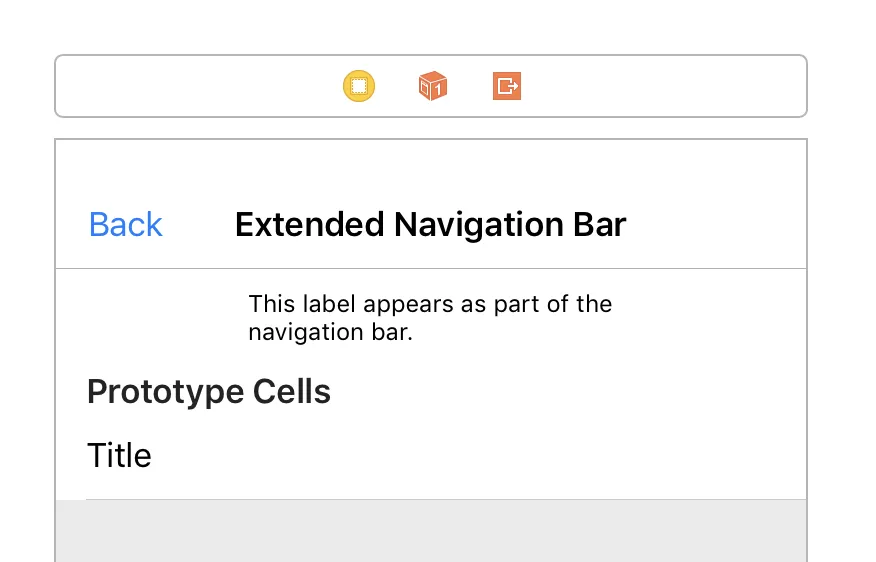
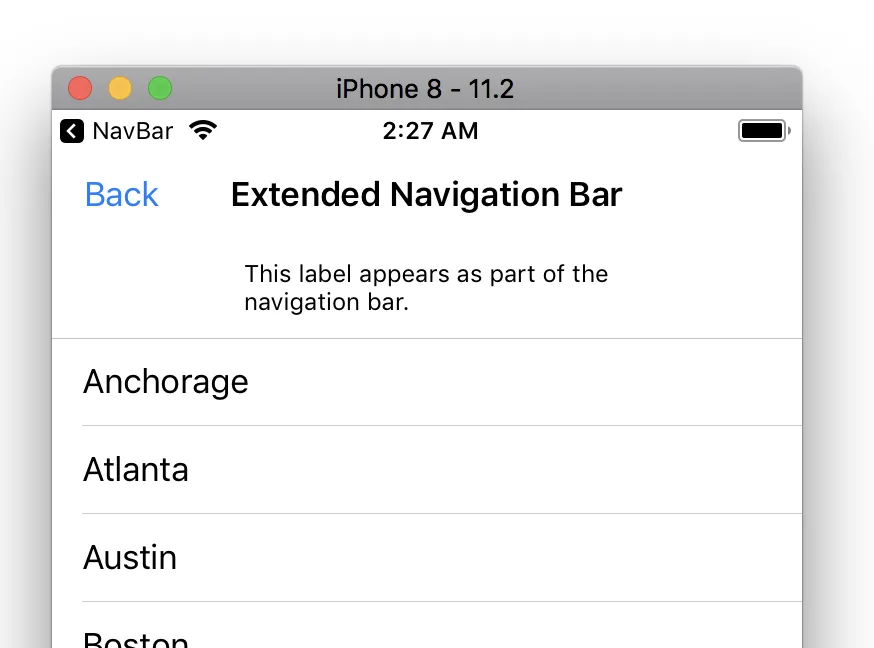
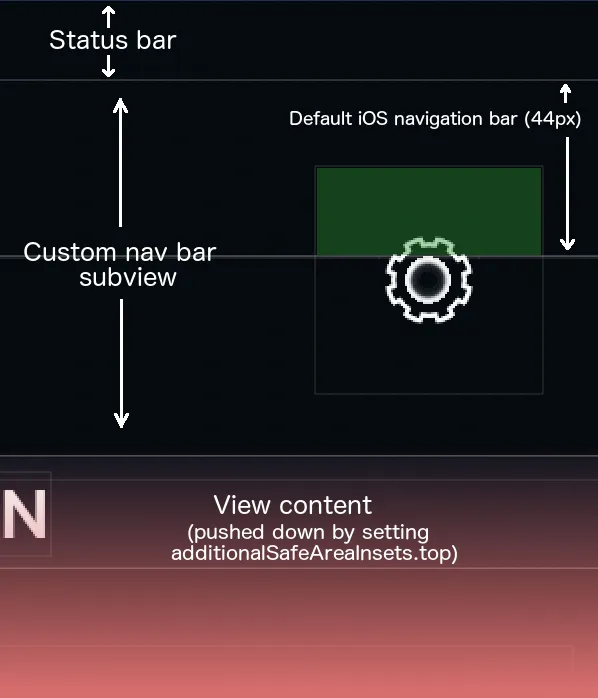
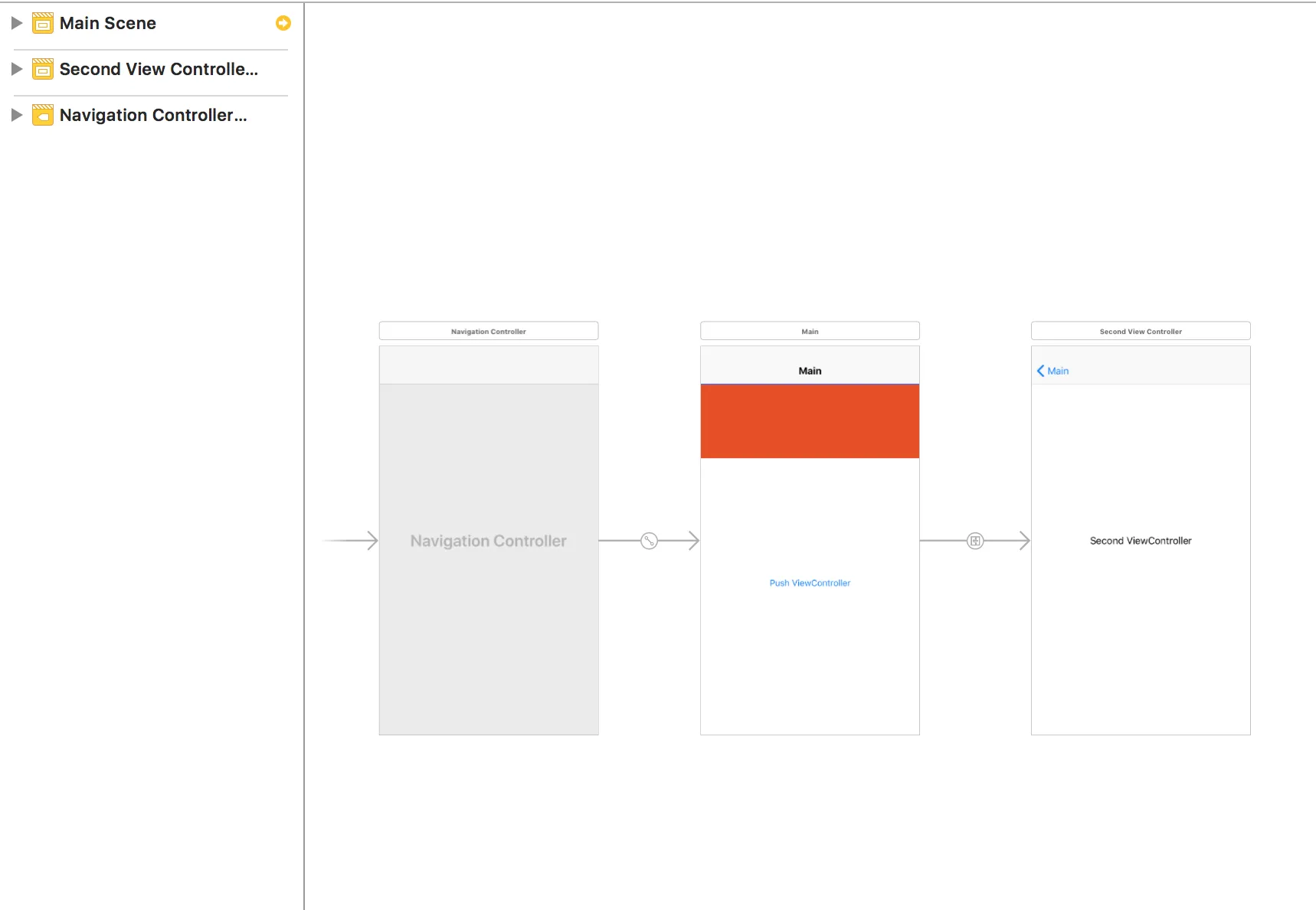
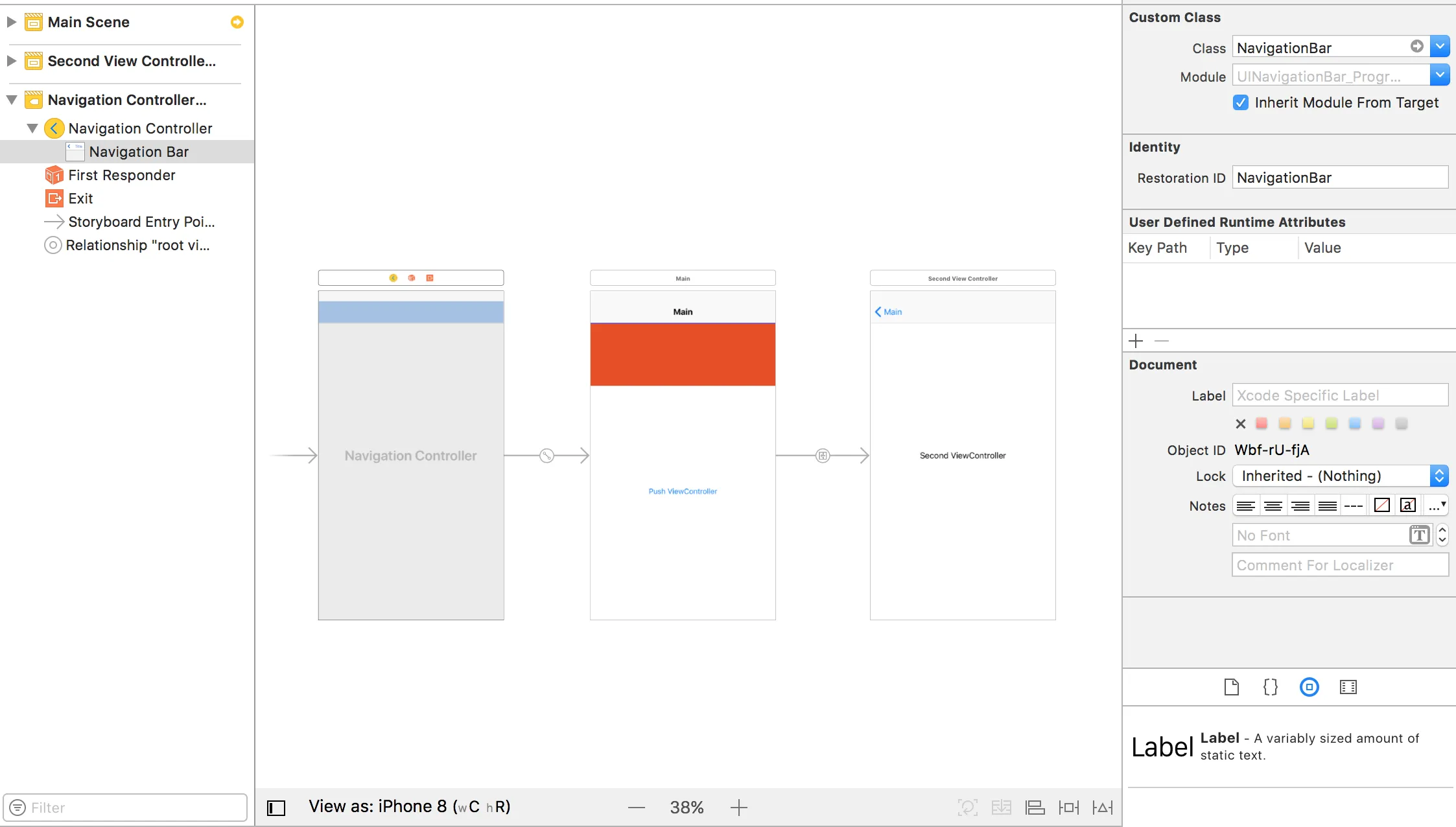
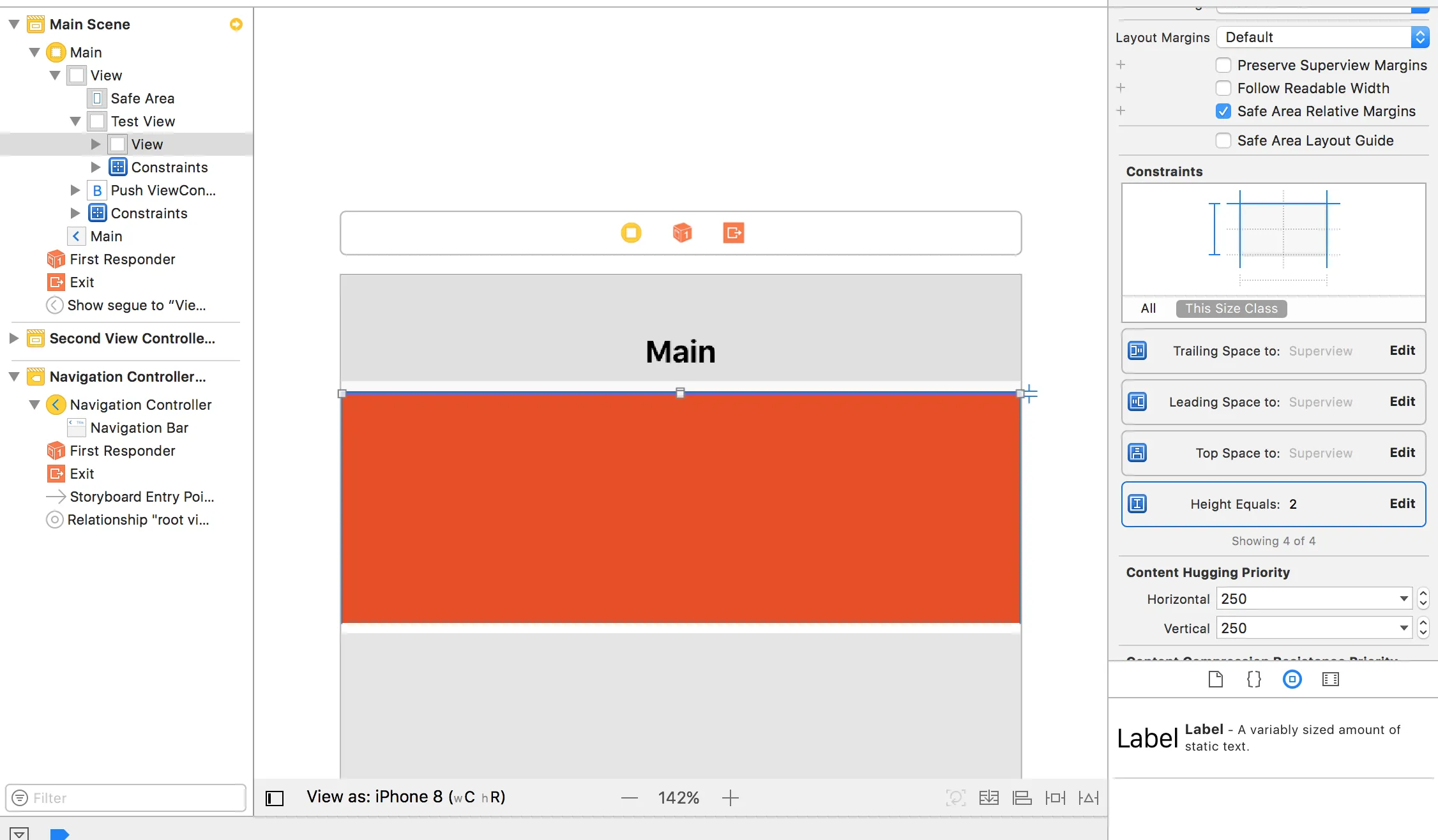
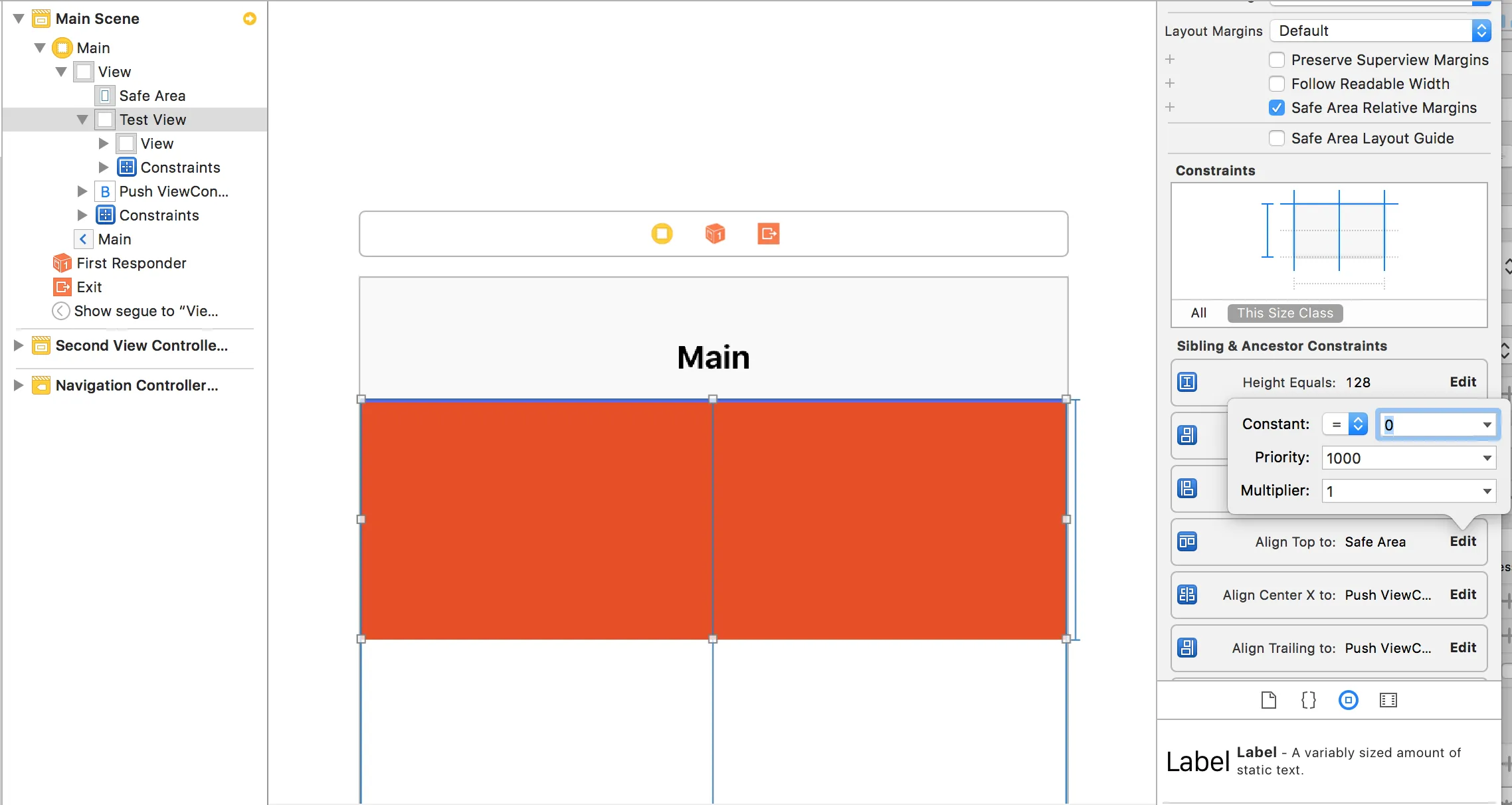
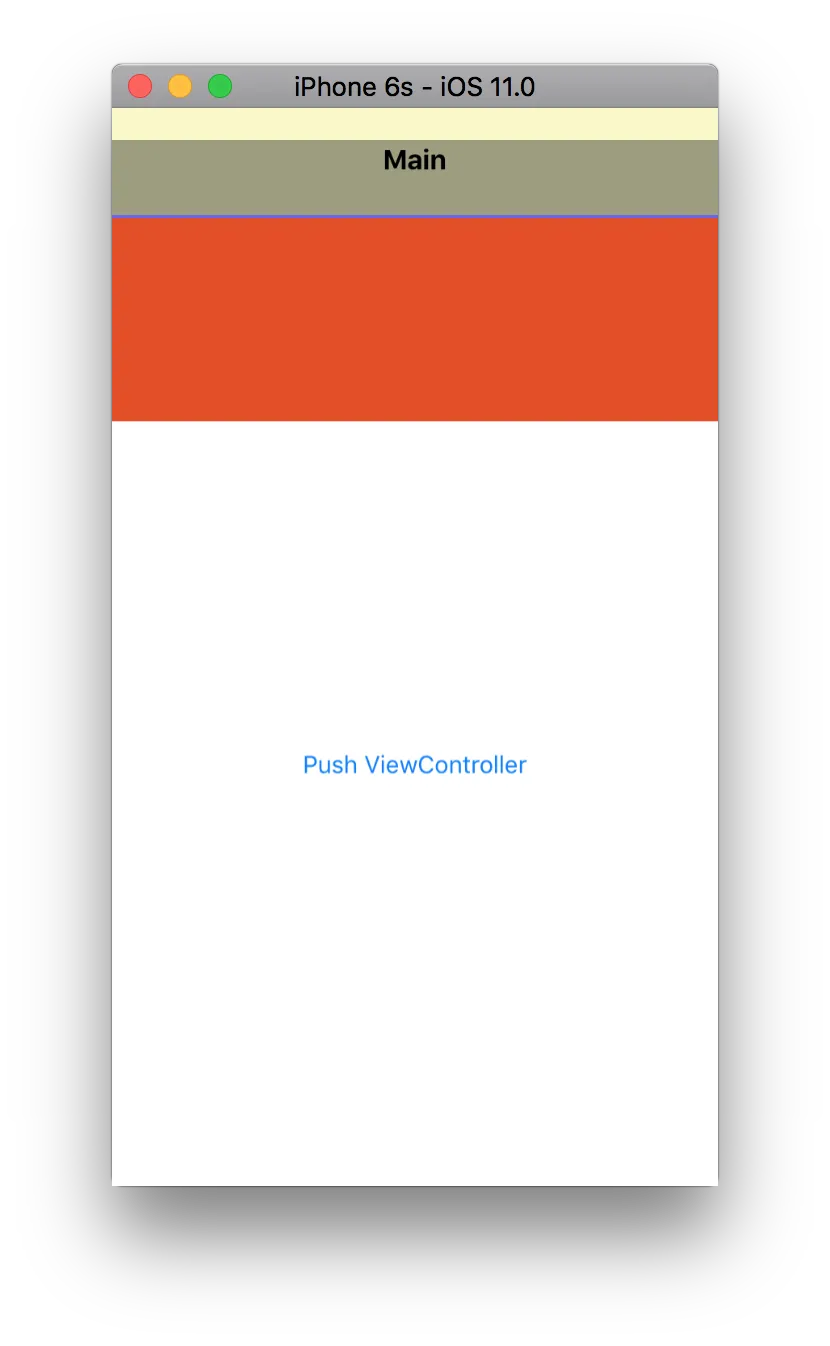
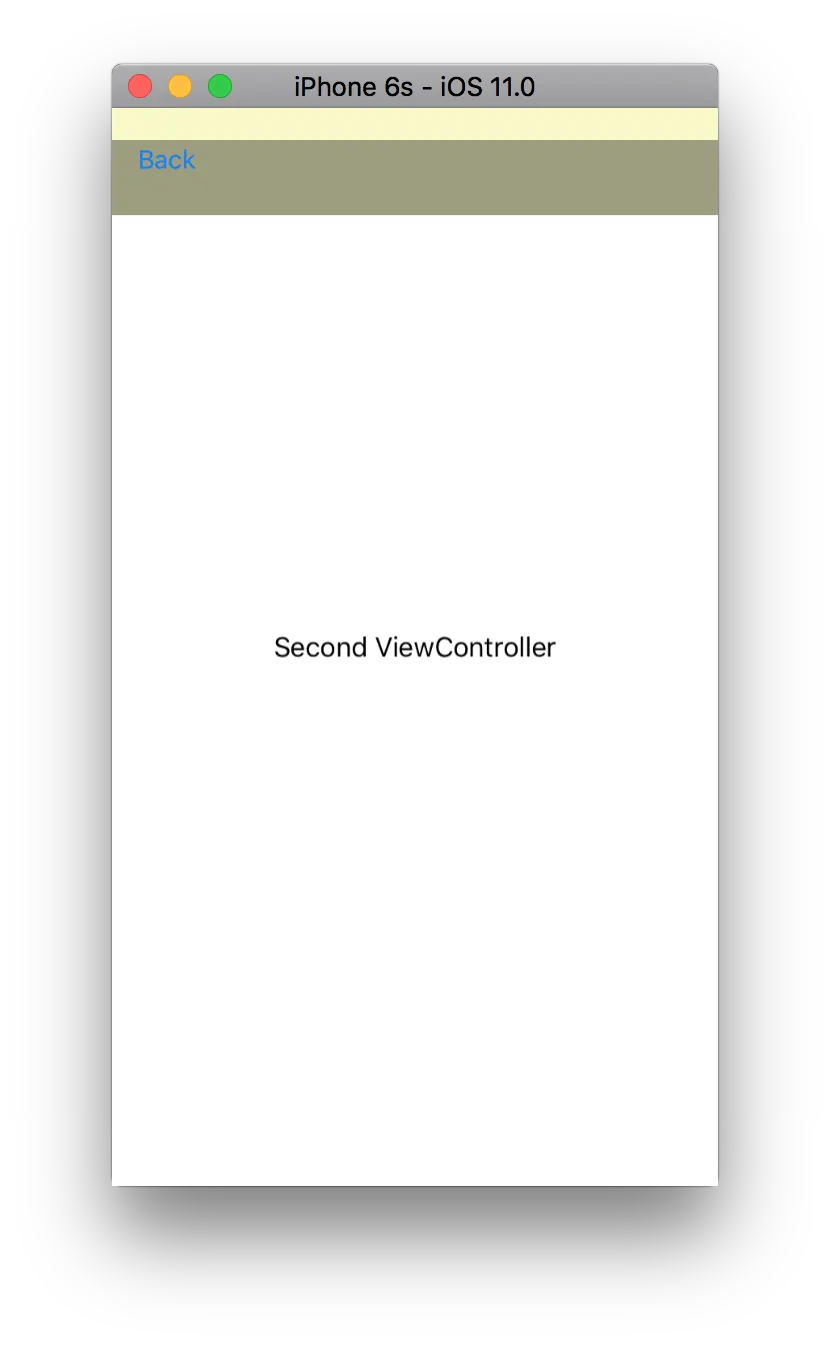
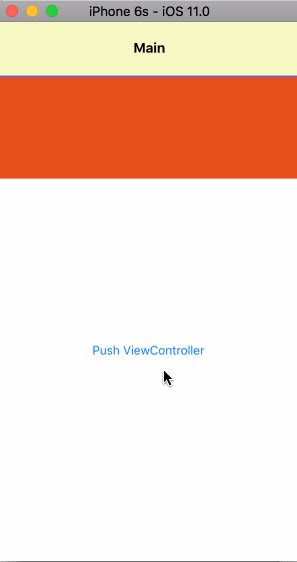
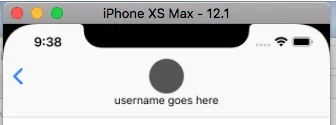

UINavigationBar故意不再使用sizeThatFits来确定其大小,因为在iOS 11中具有大标题的动态更改导航栏高度。因此,我不知道除了构建自己的导航栏之外,在iOS 11中如何获得固定高度。我建议您提交增强请求,要求API影响iOS 11+的导航栏高度。 - Jordan H